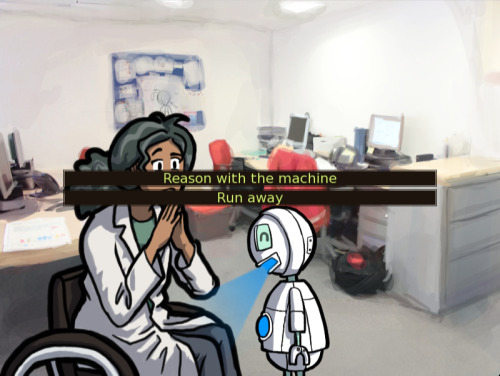A Basic Guide to Visual Novels
Tags: posts, visual novels, tutorial,
I looked around for something to include in my games and couldn't find one. Feedback very welcome, I am sure I got some of this wrong.
So! A visual novel, or VN, is an illustrated interactive story. The aim of a visual novel is not to "win" but to create an enjoyable story.
A visual novel largely consists of a sequence of static screens that the player clicks through, a bit like panels of a comic. Most of the screens contain dialogue or narration. Some contain choices that change the direction of the story.
The player character, or PC, is the viewpoint character of the game, whose actions the player controls. Making choices in a visual novel is usually a mixture of "what feels in character for the PC" and "what will get the story outcome I want".
Here is a screenshot from SOON of the player character deciding to reason with a robot or run away:

Choices often affect how the characters of the game feel about the player character, and how the game models the PC's personality. One common approach is a point system eg if you make the character Bob like the PC more you gain "Bob points", or if you make the PC behave in a cruel way you gain "cruelty points".
Common visual novel structures:
-
Kinetic novel: There are no choices, the game only plays one way.
-
Single path: There is a single basic story that is mostly the same in every game. Player choice affects side plots and other changes in how the story plays out, then heavily affects the ending.
-
Branching paths: The first part of the game follows a single "common path" with a set plot. Then the story splits into various branching paths. Which branching path the player sees depends on the choices they made during the common path. Usually each branching path has a fairly set plot, but splits into a number of possible endings near the end, based on the player's choices throughout the game. These are often referred to as Good Ends, Bad Ends etc, but may be more ambiguous.
(nb I am not sure "branching paths" is the right term)
Common visual novel genres:
-
Life sim: the player is in charge of practical concerns like making money or doing homework that affect how successful the PC is at their life.
-
Dating sim: Originally, a life sim with romance elements. These days, often used for any romance VN.
My visual novels:
- SOON is a puzzle game with single path, but you can to some extent reset where you are on that path using time travel.
- Northanger Abbey is a romance and friendship game using branching paths. The player spends the common path talking to a variety of characters. During this period they gain paints with the various characters, and also gain personality traits. They then either experience one of several short endings, or are on the longer route of the two primary love interests. If they make favorable decisions, they get a happily ever after with that love interest or friends, otherwise they get a less happy ending.
Other common terms and concepts:
These are mostly Japanese, since they invented the Visual Novel genre, but are often used differently in English to Japanese.
-
Final path: in some branching path games, once you have played all the paths you get access to a new final path that ties up all the different plot threads into one coherent story.
-
NPC: non player character. Any character other than the PC.
-
otome/otoge: aimed at women, usually a dating sim with a female protagonist and male love interests.
-
BL: about relationships between men.
-
yuri: about relationships between women.
-
Eroge/H-game: contains explicit sex scenes.
More links:
- English Otome Games: Visual novels with female protagonists aimed at women and available in English.